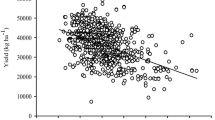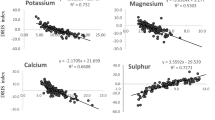Abstract
Testing and developing nutrient diagnosis methods, which can result in the optimum production of fruits, is of significance. The nutritional balance and requirements of almond (Prunus sp.) orchards, in the city of Saman (province of Chaharmahal and Bakhtiari, Iran, one of the biggest producers of almond in the country), were investigated using the methods of diagnosis and recommendation integrated system (DRIS) and deviation from optimum percentage (DOP) in a two-year research. Using 36 gardens along the Zayandehrud River in a 60-km distance, soil physical and chemical properties, as well as leaf micro- and macro-nutrient contents were determined. Similar plant samples (leaf + petiole) in terms of age, genotype and rootstock were collected from the unfruitful trees. The most deficient nutrients including S, Cu, Zn and Mn were indicated by the DRIS and DOP methods. However, according to the DRIS method Mg, and according to the DOP method N, K and Mg were determined as the most excessive macronutrients. Interestingly, both methods indicated Mo as the most excessive micronutrient. The balance indexes of different nutrients for different orchards indicated that the nutritional balances of the orchards from the highest to the least deficiency are according to the following order Cu > S > Zn > Mn > Cl > P > Ca > Mg > B > N > K > Fe > Mo. Such results indicate the precisions and some similarities between the two methods. However, the two methods were compared using SAS Proc GLM, Proc REG, and Proc NLIN. The analyses indicated that the two methods were significantly different and the DOP method (significant model) indicated higher correlation with the results. Accordingly, the DOP method may be a more accurate method of estimating almond yield as affected by the concentration of different nutrients. It is possible to determine the deficiency, balance and excessiveness of nutrients in almond orchards using the DRIS and DOP methods, which is of economic and environmental significance, worldwide.


Similar content being viewed by others
References
Barłóg P (2016) Diagnosis of sugar beet (Beta vulgaris L.) nutrient imbalance by DRIS and CND-clr methods at two stages during early growth. J Plant Nutr 39:1–16
Beigi M, Torki-Harchegani M, Ghanbarian D (2016) Energy use efficiency and economical analysis of almond production: a case study in Chaharmahal-Va-Bakhtiari province, Iran. Energy Efficiency 9:745–754
Bremner, J.M., Mulvaney, C.S., 1982. Nitrogen—Total 1. Methods of Soil Analysis. Part 2. Chemical and Microbiological Properties, pp.595–624.
Chanan M, Hardiwinoto S, Agus C, Hadi Purwanto R, Purwanta S (2019) The identification of macro nutrient status of superior teak plantation (Tectona grandis Lin. F) by means of DRIS norms (Diagnosis and Recommendation Integrated System) in Indonesia. Forest Sci Technol 15:7–12
Doostikhah N, Panahpour E, Nadian H, Gholami A (2020) Tomato (Lycopersicon esculentum L.) nutrient and lead uptake affected by zeolite and DTPA in a lead-polluted soil. Plant Biol 22:317–322
Gee, G.W., Bauder, J.W., 1986. Particle-size analysis 1. Methods of Soil Analysis: Part 1—Physical and Mineralogical Methods, pp.383–411.
Gharaghani A, Solhjoo S, Oraguzie N (2017) A review of genetic resources of almonds and stone fruits (Prunus spp.) in Iran. Genet Resour Crop Evol 64:611–640
Jones Jr, J.B., Wolf, B., Mills, H.A., 1991. Plant Analysis Handbook. A Practical Sampling, Preparation, Analysis, and Interpretation Guide. Micro-Macro Publishing, Inc..
Jones Jr, J.B., 1997. Field sampling procedures for conducting a plant analysis. In: Handbook of Reference Methods for Plant Analysis (pp. 40–50). CRC Press.
Kumar P, Sharma SK, Kumar A (2017) Foliar nutritive fluids affect generative potential of apples: Multilocation DOP indexing and PCA studies under dry temperate agro-climatic conditions of north-west Himalaya. Sci Hortic 218:265–274
Maity A, Sharma J, Sarkar A, More AK, Pal RK (2016) Nutrient imbalance indices are closely related with susceptibility of pomegranate to bacterial blight disease. Sci Hortic 211:79–86
Mestre L, Reig G, Betrán JA, Pinochet J, Moreno MÁ (2015) Influence of peach–almond hybrids and plum-based rootstocks on mineral nutrition and yield characteristics of ‘Big Top’nectarine in replant and heavy-calcareous soil conditions. Sci Hortic 192:475–481
Mirabdulbaghi M (2014) Investigations on determination of nutritional status of pear trees according to a new index-deviation from optimum percentage (DOP). Cercetari Agronomice Moldova 47:83–98
Miransari M, Bahrami HA, Rejali F, Malakouti MJ (2008) Using arbuscular mycorrhiza to alleviate the stress of soil compaction on wheat (Triticum aestivum L.) growth. Soil Biol Biochem 40:1197–1206
Miransari M (2011) Soil microbes and plant fertilization. Appl Microbiol Biotechnol 92:875–885
Miransari M (2012) Soil Nutrients. Nova Science Publishers, New York, USA
Miransari M, Riahi H, Eftekhar F, Minaie A, Smith DL (2013) Improving soybean (Glycine max L.) N2 fixation under Stress. J Plant Growth Regul 32:909–921
Miransari M, Smith D (2019) Sustainable wheat (Triticum aestivum L.) production in saline fields: a review. Critical Rev Biotechnol 39(8), 999–1014.
Mohammadi M, Asadi-Gharneh HA (2018) How geographical differences may affect the uptake of nutrients by the wild populations of pennyroyal [Mentha longifolia. (L.), Huds]. CATENA 165:173–177
Nelson, D.W., Sommers, L., 1982. Total carbon, organic carbon, and organic matter 1. Methods of Soil Analysis. Part 2. Chemical and Microbiological Properties, pp.539–579.
Rabadán A, Pardo JE, Pardo-Giménez A, Álvarez-Ortí M (2018) Effect of genotype and crop year on the nutritional value of walnut virgin oil and defatted flour. Sci Total Environ 634:1092–1099
Rabadán A, Álvarez-Ortí M, Pardo JE (2019) A comparison of the effect of genotype and weather conditions on the nutritional composition of most important commercial nuts. Sci Hortic 244:218–224
Reig G, Lordan J, Fazio G, Grusak MA, Hoying S, Cheng L, Francescatto P, Robinson T (2018) Horticultural performance and elemental nutrient concentrations on ‘Fuji’grafted on apple rootstocks under New York State climatic conditions. Sci Hortic 227:22–37
Rhoades, J.D., 1996. Salinity: Electrical conductivity and total dissolved solids. Methods of Soil Analysis Part 3—Chemical Methods, pp.417–435.
Sabet H, Mortazaeinezhad F (2018) Yield, growth and Fe uptake of cumin (Cuminum cyminum L.) affected by Fe-nano, Fe-chelated and Fe-siderophore fertilization in the calcareous soils. J Trace Elem Med Biol 50:154–160
Savita S, Krishnappa R, Ngangom B, Devi MT, Mishra G, Rawat D, Srivastava PC (2016) Diagnosis and recommendation integrated system (DRIS) approach on nutritional diagnosis in fruit crops—a review. J Appl Nat Sci 8:2337–2345
Singh, S.R., 2016. Soil test crop response: Concepts and components for nutrient use efficiency enhancement. In: Biofortification of Food Crops (pp. 237–246). Springer, New Delhi.
Soltanpour PN, Malakouti MJ, Ronaghi A (1995) Comparison of diagnosis and recommendation integrated system and nutrient sufficiency range for corn. Soil Sci Soc Am J 59:133–139
Thomas, G.W., 1996. Soil pH and soil acidity. Methods of Soil Analysis part 3—Chemical Methods, pp.475–490.
Torki-Harchegani M, Ebrahimi R, Mahmoodi-Eshkaftaki M (2015) Almond production in Iran: an analysis of energy use efficiency (2008–2011). Renew Sustain Energy Rev 41:217–224
Yada S, Huang G, Lapsley K (2013) Natural variability in the nutrient composition of California-grown almonds. J Food Compos Anal 30:80–85
Acknowledgements
The authors would like to thank very much AbtinBerkeh Scientific Ltd. Company (https://AbtinBerkeh.com), Isfahan, Iran, for editing the manuscript and revising it according to the journal format.
Funding
There was not any funding for this research.
Author information
Authors and Affiliations
Corresponding author
Ethics declarations
Conflict of interest
The authors declare that they do not have any conflict of interest.
Additional information
Publisher's Note
Springer Nature remains neutral with regard to jurisdictional claims in published maps and institutional affiliations.
Rights and permissions
About this article
Cite this article
Chaleshtori, A.A., Panahpour, E., Iranipour, R. et al. Diagnosing the Nutritional Balance of Almond (Prunus sp.) Orchards Using DRIS and DOP Methods. J Plant Growth Regul 40, 1640–1651 (2021). https://doi.org/10.1007/s00344-020-10214-0
Received:
Accepted:
Published:
Issue Date:
DOI: https://doi.org/10.1007/s00344-020-10214-0




